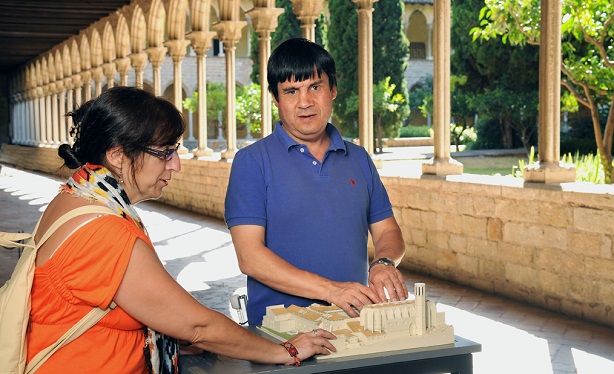Reial Monestir de Santa Maria de Pedralbes

Barcelona's Museu-Monestir de Pedralbes is considered to be one of the finest examples of Catalan Gothic architecture and allows us to see the artistic legacy preserved by the community of nuns from the Order of Saint Clare throughout the centuries and to find out about the way they live.
The Royal Monastery of Santa Maria de Pedralbes was founded by Queen Elisenda of Montcada at the beginning of the 14th century. It was home to a community of Poor Clares and consists of a church and monastery set around impressive three-tier cloisters, which are among the biggest and best preserved in Europe.
The harmonious structure is surrounded by the main rooms: the dormitory, the refectory, the chapterhouse, the abbey and the nuns' day cells, one of which contains Ferrer Bassa's splendid Gothic mural paintings. It also preserves numerous works of art, paintings, ceramics, furniture, silverware, goldware, liturgical ornaments, fabrics and documentation which the community of nuns has collected over the centuries.
All these pieces are associated with the everyday life of the nuns or with the objects the nuns brought with them when they joined the religious order, or which the community of nuns acquired to decorate the monastery, mainly in places of worship such as the church. Some of these objects can be seen on display in the dormitory in the Treasures of the Monastery exhibition. Visitors can also explore the recreation of a medicinal garden with fifty-one plant species with medicinal properties. Through the Sala de les Procures, where food was stored, you can access the medieval garden of the monastery, where the garden products were grown by the nuns in the Middle Ages.
Highlights inside the church include the tomb of the monastery's founder, Queen Elisenda of Montcada, as well as those of the noble families who played an important role in the history of Catalonia: the Pinós and Cardona dynasties, and even Antoni Gaudí's patron, Count Eusebi Güell. Curiously enough, the church was remodelled at the end of the 19th century by Gaudí's teacher, the architect Joan Martorell.
An exceptional place that invites you to meditate in peaceful surroundings as it is situated in one of the most tranquil places in the city. It also has an interesting calendar of events, including visits, concerts, lectures and temporary exhibitions.

Back to index
General details
Address: Baixada del Monestir, 9 (08034). Barcelona
Phone: 932 563 434
Web site: http://monestirpedralbes.bcn.cat
Opening time: April - September: Tuesday to Friday, from 10am to 5pm. Saturday, from 10am to 7pm. Sunday from 10am to 8pm. Public holidays, from 10am to 2pm. | October - March: Tuesday to Friday, from 10am to 2pm. Saturday and Sunday, from 10am to 5pm. Public holidays, from 10am to 2pm. | Closed: January 1st, May 1st, June 24th and December 25th.
Magic hour: Free access to the cloister. Tuesday and Friday, from 6 to 9 p.m.. From June 6 to September 15 2023.
Back to index
Accessibility details
As it is a historic building, Pedralbes Monastery has some architectural barriers. All possible measures have been taken to ensure access for reduced-mobility visitors. However, wheelchair users may require assistance.
There is an audio guide for adults (in English, Catalan, Spanish, French, German and Italian) as well as a version for children (in Catalan and Spanish).
The audioguides are included in the ticket price.
The Pedralbes monastery participates in the social and educational program
Apropa Cultura (Closer to Culture)
The sensory activity “Walk of Perceptions” is one of the projects the monastery has launched. It has been specially designed for children with special needs.

There are tactile scale models, labelled in ink and Braille: one that reproduces all the architectural details of the monastery; and one of queen Elisenda tomb.
There is a relief plan of the monastery floor plan and all its rooms. It is labelled in ink and Braille.
The lift button panels have raised lettering and Braille.

FM transmitters can be hired for all activities.
Visitors can ask for a sign language interpreter for guided tours, lectures and other activities. These must be requested a week in advance through the MUHBA booking centre. Tel: 932 562 122 (Monday to Thursday, 10am-2pm and 4pm-7pm. Friday, 10am-2pm)
reservesmuhba@bcn.cat

The main entrance to the museum has a number of steps and is not accessible. There is a second entrance with ramps which is quite steep in places.
Almost all the monastery is accessible with the assistance of a companion. There are ramps in most of the visitor areas.
The centre of the cloister is a landscaped area with tiled walkways or paths (the surface is even despite the age of the tiles). This central area is raised slightly above the cloister galleries and is accessed by two steps. In spite of this, there is a mobile metal ramp at one of the entrances that allows wheelchair users to access the centre of the cloisters. The ramp is extendible and has no handrails.
There are two lifts that connect the different levels of the monastery.
There are adapted toilets on the ground floor by the entrance.

The monastery is part of a project entitled “Beauty Heals” which has been designed for the relatives of people with disabilities and disability associations, based on the therapeutic effects of art.
Last update: 01/08/2023
Back to index
Booking
Purchase on-line. BCN Shop: Virtual shop run by Turisme de Barcelona where you can purchase tourist products and services.
Back to index
Send your comment about this information (will not be published)
Back to index
